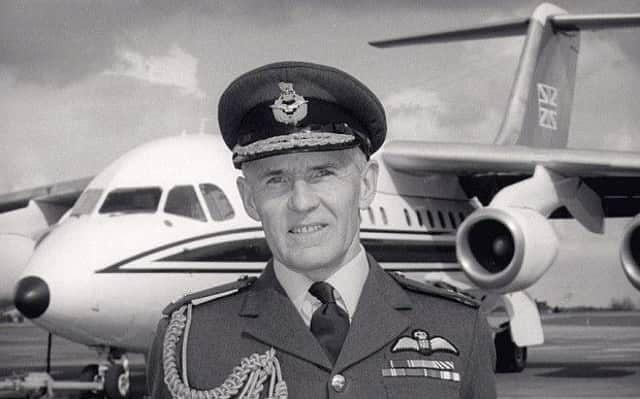Obituary: Air Vice-Marshal Sir John Severne


Born: 15 August, 1925, in London.
Died: 4 October, 2015, in Somerset, aged 90.
Air Vice-Marshal Sir John Severne was a Cold War fighter pilot who was commander of RAF Kinloss when much intense surveillance was carried out. He was Equerry to the Duke of Edinburgh and appointed Captain of the Queen’s Flight. Severne’s distinguished career in the RAF ranged from flying post-war fighters and jet trainers to the Nimrod maritime patrol aircraft. He won the King’s Cup Air Race in 1960 and became the British Air Racing Champion the same year.
John Severne was the son of a Royal Flying Corps doctor and after Marlborough, where he showed a passion for aeroplanes and light aircrafts, especially Gipsy Moths, he joined the RAF in April 1944 and gained his wings a few weeks after the war ended. He flew the Mosquito night fighter with 264 Squadron for two years, before leaving for further studies at the Central Flying School, where he trained as a flying instructor and taught student pilots and instructors.
Advertisement
Hide AdAdvertisement
Hide AdOn the course he flew a Lancaster, Spitfire and his first jet - the Vampire. In January 1954, he joined No. 98 Squadron, flying Venom day fighter/ground attack aircraft based in northern Germany and his skills were recognised when he was appointed a flight commander.
On 1 November, 1954 he was carrying out a looping manoeuvre when the engine of his Venom caught fire. With much foresight he decided not to bail out – so that comprehensive investigations could be carried out – and landed with flames billowing from the fuselage. For his gallantry he was awarded the AFC.
He converted to the Hunter fighter in January 1956 and took command of No 26 Squadron based in northern Germany. After the 1957 Defence White Paper which made heavy cuts throughout the services the squadron was disbanded.
The following year Severne was appointed Equerry to Prince Philip, and his duties included accompanying the Prince on foreign trips and ensuring his travel arrangements were well organised. As an extra to his many duties in the RAF, Severne learnt to fly helicopters.
In 1961 he returned to active service with the RAF and was appointed wing commander flying at RAF Middleton St George (now Teesside Airport). When it was closed Severne became the chief instructor of the Lightning Operational Conversion Unit at Coltishall in Norfolk.
In 1966 Severne was sent to Aden as Wing Commander Ops: Aden was experiencing political turmoil and his post called for much tact and diplomacy. Severne was responsible for the operations of fighter and reconnaissance aircraft and ensuring there was helicopter support for military sorties. Severne himself regularly patrolled the Yemen border and attacked dissident camps. His base was also heavily involved in the Beira Patrol which supervised the Rhodesian oil embargo. In 1967 Severne was amongst the last RAF officers to leave Aden.
In 1971 Severne was appointed Commander of RAF Kinloss which was an important base throughout the Cold War and the largest maritime RAF base in Scotland. It had opened in 1939 and served as a vital training station throughout the Second World War. After the war it was handed over to Coastal Command to monitor Russian ship movements in the North Sea and was the main base for the RAF’s fleet of Nimrod MR2 aircrafts.
Severne had under his command three squadrons of Nimrods which patrolled the North Atlantic shadowing Soviet submarines and powerful surface fleets. He himself often led patrols and recalled: “Flying low over the sea at 200 ft, at night, in bad weather, 1,000 miles over the North Atlantic, concentrates the mind no end.”
Advertisement
Hide AdAdvertisement
Hide AdAs Station Commander of Kinloss, Severne was responsible for developing the Nimrod to its maximum capacity: at the height of the Cold War the squadron performed a vital part of Britain’s defence.
Their versatility and manoeuvrability in the air also proved invaluable during the Cod Wars.
During his command of Kinloss, the station was awarded the Wilkinson Sword of Peace for 1971 for “making an outstanding contribution to community relations”, which he accepted from the Duke of Edinburgh. In 1972 he was appointed as an ADC to the Queen.
Prince Philip wrote the Forward to Severne’s memoirs, Silvered Wings. “John Severne is a very lucky fellow,” the Prince wrote. “There are not many people who have a single-minded ambition about what they want to do with their lives; who manage to realise that ambition, and then turn out to have a real talent for it. His infectious enthusiasm for the sheer joy of flying oozes from every chapter.”
Severne, who celebrated his 90th birthday by taking the controls of a Tiger Moth, married Katharine Kemball in 1951. She and their three daughters survive him.
ALASDAIR STEVEN